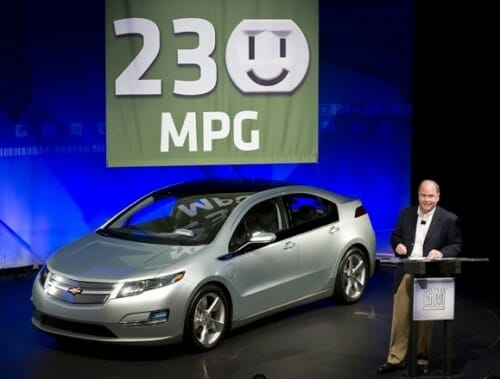230 MPG?
Update: 230 MPG turns out to be, as I suspected, total BS. Make sure to check out update at bottom
Apparently under new methodology, the Chevy Volt got an MPG rating of 230.
we're told that the Volt has snagged a staggering 230 MPG rating in the city, but we should caution you that it's not as cut and dry as GM would have you believe. The EPA has released "a new methodology for determining a draft fuel economy standard for extended-range EVs like the Volt," and it's that murky measurement system that has blessed Chevy's wonder child with a triple digit MPG rating.

Forget for the fact that the whole terminology is meaningless, as the vehicle only burns liquid fuel for a portion of its energy needs, so "miles per gallon" is an odd concept. But one could imagine that one could look at the miles per electrical charge, and then look at the equivalent gallons of gasoline-equivalent BTU's it took to deliver that electricity, and create an equivalent MPG. In fact, that's the only approach that makes any sense to me.
If so, these numbers imply that it is 10x more efficient to burn hydrocarbons in a large utility plant boiler or gas turbine, convert the combustion energy to electricity, transmit that electricity hundreds of miles, charge up a set of car batteries, and then drive an electric traction motor from the batteries than it is to burn hydrocarbons directly in an internal combustion engine in the vehicle.
If this is really the case, then I have been selling electric cars short and we will all soon be buying them (I prefer the performance of an electric engine so this kind of fuel savings is just icing on the cake). However, I have my doubts. While certainly a large power station is much more efficient in using all the BTU's in a fuel than is an internal combustion engine, when one considers losses in the electrical generation and line losses, I find it very very hard to believe the difference is 10x.
But I am sure there is no conflict of interest here, and that it is pure coincidence that GM is owned by the same people who created the new methodology and did the testing, and given that the new methodology was created by the same people who have been pushing electric cars as a policy alternative.
Update: The 230 MPG figure is even more BS than I thought. Apparently, MPG while running on batteries is treated as infinite! In other words, electricity is treated as "free" and not costing anthing in terms of fuel. Check out how the math is done
When gasoline is providing the power, the Volt might get as much as 50 mpg.
But that mpg figure would not take into account that the car has already gone 40 miles with no gas at all.
So let's say the car is driven 50 miles in a day. For the first 40 miles, no gas is used and during the last 10 miles, 0.2 gallons are used. That's the equivalent of 250 miles per gallon. But, if the driver continues on to 80 miles, total fuel economy would drop to about 100 mpg. And if the driver goes 300 miles, the fuel economy would be a just 62.5 mpg.
This is entirely consistent with the bizarre way electric cars have always been treated by environmentalists and politicians, as if the electricity is free and they have no hydrocarbon use or CO2 production. Which is weird, since we get harangued for our incandescent light bulbs destroying the world when we plug them in but plugging in a whole car does not?
That being said, if one really wanted to move away from hydrocarbon fuels, the smart approach is probably to go with electric cars and then attack electricity generation rather than transportation. I will feel good plugging in my car because the juice will come from a big honking zero-emissions nuclear plant.